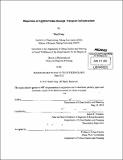| dc.contributor.advisor | Karen R. Polenske. | en_US |
| dc.contributor.author | Fang, Wanli, Ph. D. Massachusetts Institute of Technology | en_US |
| dc.contributor.other | Massachusetts Institute of Technology. Department of Urban Studies and Planning. | en_US |
| dc.date.accessioned | 2013-10-24T17:37:48Z | |
| dc.date.available | 2013-10-24T17:37:48Z | |
| dc.date.copyright | 2013 | en_US |
| dc.date.issued | 2013 | en_US |
| dc.identifier.uri | http://hdl.handle.net/1721.1/81637 | |
| dc.description | Thesis (Ph. D.)--Massachusetts Institute of Technology, Dept. of Urban Studies and Planning, 2013. | en_US |
| dc.description | Cataloged from PDF version of thesis. | en_US |
| dc.description | Includes bibliographical references (p. 191-199). | en_US |
| dc.description.abstract | My dissertation aims to assess transport infrastructure's influence on the productivity, scale and distribution of urban economic activities through changing intercity accessibility. Standard project-level cost-benefit analysis fails to capture the economy-wide impacts in justifying investments in the transport sector. I propose a research framework that: (1) synthesizes the spatial emphasis of the New Economic Geography theories with the temporal perspective of the growth theories; (2) extends the scope of agglomeration effects by highlighting a city's access to external resources as a partial substitute for its own endowment; and (3) bridges the spatial discontinuity between regional and urban studies by introducing intercity accessibility as a determinant of intra-city land uses. I apply the proposed framework to study the spatial economic impacts of China's high-speed rail system at network, corridor, and node (city) levels. The GIS-based spatial analyses of the network accessibility measured by three alternative indicators consistently illustrate that, the extensive transport investments during 2001-2010 have reduced the disparities in accessibility among cities in China, with the coefficient of variation dropping by nearly 50%. Differently, estimations from the panel data models shed light on the complexity in the relationship between accessibility and economic activities, which consists of both generative and redistributive components and simultaneously leads to convergent and divergent economic outcomes. Yet, empirical evidence denies the saturation effects of accessibility. Extended estimations using different instrument variables (IV) partially relieve the concerns on endogeneity issues. Further analyses of a particular transport corridor reveal that, with HSR, the regional urban hierarchy is evolving towards a more interwoven structure, with major cities reaching for overlapped hinterlands. HSR's short-run influences on the location choice of economic activities vary in terms of spatial coverage and are not necessarily restricted to cities with direct HSR access. The city-level comparative case studies indicate that HSR stations introduce external demand for urbanization, leading to new development once matching land supply exists. A cluster analysis of ten demand-supply-related factors generates three prototypes of station-area development. For each type, public and private sectors have adopted different institutional arrangements, yet common challenges exist in preventing speculative investments and matching the development portfolio with the composition of actual needs. The findings lead to important policy implications for decision-makers in China. First, China has not exhausted the agglomeration benefits dispersing through transport infrastructure given the remarkable regional disparities. From an economic development perspective, HSR lines connecting coastal megacities with lagging inland cities are effective in reducing disparities in accessibility and should be encouraged. Second, for the appraisal of major transport projects including HSR, it is reasonable to extend the standard CBA to include the generative benefits; to evaluate the impacts on regional disparities based on redistributive effects; and to avoid overbuilding through identification of saturation effects. Third, HSR has the potential to reshape the path of urbanization. The evolution of the urban hierarchy towards a more interwoven structure may eventually raise the need for adapting administrative arrangements to fit the actual economic interaction. As to urban configuration, HSR stations may catalyze compact urbanization around transit facilities. However, local governments should avoid using HSR stations as a vehicle for excessive generation of land concession revenues. | en_US |
| dc.description.statementofresponsibility | by Wanli Fang. | en_US |
| dc.format.extent | 228 p. | en_US |
| dc.language.iso | eng | en_US |
| dc.publisher | Massachusetts Institute of Technology | en_US |
| dc.rights | M.I.T. theses are protected by
copyright. They may be viewed from this source for any purpose, but
reproduction or distribution in any format is prohibited without written
permission. See provided URL for inquiries about permission. | en_US |
| dc.rights.uri | http://dspace.mit.edu/handle/1721.1/7582 | en_US |
| dc.subject | Urban Studies and Planning. | en_US |
| dc.title | Dispersion of agglomeration through transport infrastructure | en_US |
| dc.type | Thesis | en_US |
| dc.description.degree | Ph.D. | en_US |
| dc.contributor.department | Massachusetts Institute of Technology. Department of Urban Studies and Planning | |
| dc.identifier.oclc | 859404663 | en_US |
